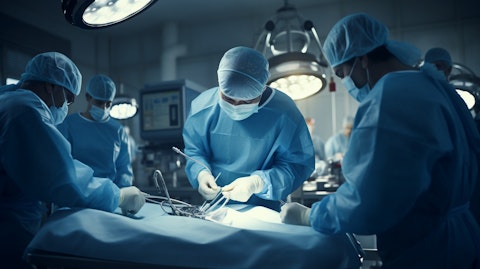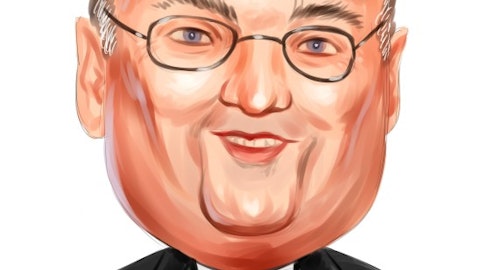Intuitive Surgical, Inc. (NASDAQ:ISRG) Q3 2023 Earnings Call Transcript October 19, 2023
Intuitive Surgical, Inc. beats earnings expectations. Reported EPS is $1.46, expectations were $1.41.
Operator: Thank you, everyone, for standing by. Welcome to the Intuitive Surgical Q3 2023 Earnings Release. [Operator Instructions] I will now turn the conference over to your host, Head of Investor Relations, Intuitive Surgical, Brian King. Please go ahead.
Brian King: Good afternoon, and welcome to Intuitive’s third quarter earnings conference call. With me today, we have Gary Guthart, our CEO; Jamie Samath, our CFO; and Dr. Myriam Curet, our Chief Medical Officer. Before we begin, I would like to inform you that comments mentioned on today’s call may be deemed to contain forward-looking statements. Actual results may differ materially from those expressed or implied as a result of certain risks and uncertainties. These risks and uncertainties are described in detail in our Securities and Exchange Commission filings, including our most recent Form 10-K filed on February 10, 2023, and Form 10-Q filed on July 24, 2023. Our SEC filings can be found through our website or at the SEC’s website.
Investors are cautioned not to place undue reliance on such forward-looking statements. Please note that this conference call will be available for audio replay on our website at intuitive.com on the Events section under our Investor Relations page. Today’s press release and supplementary financial data tables have been posted to our website. Today’s format will consist of providing you with highlights of our third quarter results, as described in our press release announced earlier today, followed by a question-and-answer session. Gary will present the quarter’s business and operational highlights, Jamie will provide a review of our financial results, Myriam will present clinical highlights, and I will discuss procedure details and provide our updated financial outlook for 2023.
And finally, we will host a question-and-answer session. With that, I will turn it over to Gary.
Gary Guthart: Thank you for joining us today. In this third quarter, we saw a strong growth in procedures performed by our customers, solid new system placements and healthy growth in utilization amid market conditions that remain largely consistent with Q2. Our new platforms continue to gain ground with Ion installs and procedure growth continuing, SP installs and procedure growth modestly accelerating and healthy growth in customer use of our digital tools. Turning first to procedures. da Vinci procedure growth in the quarter was 19%. Areas of strength included general surgery for benign conditions, particularly in the United States and broad regional growth with Germany, Japan, the U.K. and India standouts. China procedure growth was in line with our global average in the quarter.
U.S. dermal surgery procedure growth was led by cholecystectomy and colon resection. Ion procedures showed continued strength with 125% growth in the quarter. SP procedure growth accelerated with 54% global growth in the quarter driven by strength in the United States. On the capital front, we placed 312 systems in Q3 compared with 305 systems in Q3 of last year. Our clinical installed base now stands 8,127 multiport da Vinci systems, 490 Ion systems and 158 single-port da Vinci systems. Overall, our capital placement trends reflect demand for additional capacity in multiport, continued greenfield interest in our Ion system and a modest acceleration for placements of SP. The proportion of leases for new capital placements accelerated in the quarter with the U.S. using the highest leasing rates.
We think the acceleration in leasing reflects the convenience of our leasing program and the maturity of our Generation 4 multiport systems. While leasing reduces in-quarter revenue relative to capital purchase, total economics are healthy for our customer and for us. Leasing allows our customers to build clinical capacity when and where they need it and provides predefined pathways for our new technology as it enters the market. The growth rate in system utilization, defined as procedures per installed system per quarter was 6%, down from 9% last quarter while still above historical growth rates. Strong procedure growth and increased proportion of use in benign indications shortens average procedure times and needs of scheduling. Higher utilization increases our customers’ return on invested capital and is economically healthy for us.
Turning to our finances. Our revenue grew 12% in the quarter and our operating expenses were within our spend guidance. Our spending reflects continued investments in research and development to support the growth of our platforms and digital tools, expansion of our manufacturing and commercial footprints and capital amortization. Looking at the broader picture, our fourth-generation da Vinci platform is operating at global scale and embedded in a robust ecosystem of instruments, accessories, training and services. Customer acceptance of our Ion platform is strong. Acceptance of our da Vinci SP is accelerating with new indications in the pipeline, and our digital tools are building momentum through their early stages. We welcome Dr. Myriam Curet, Intuitive’s Chief Medical Officer to this call, and she will take us through our clinical perspective and some of the work we’re doing to expand indications.
Our operations teams did a fantastic job supporting our customers through the supply chain shocks of the past several years. This unavoidable effort diverted resources away from product cost reduction and as supply chain stresses ease, we’re now pivoting our attention to once again lowering our product costs. Areas of opportunity include our Ion program, our SP accessories portfolio and our multiport accessories in advanced instrument lines. Given the timing of facilities completion, manufacturing efficiency improvements for new products and other complex projects, we expect variability in gross margin over the coming quarters as we work through these programs. Turning to our digital offerings, customer use of our digital tools and channels is growing nicely.
Our SimNow surgical simulators are installed at the majority of our customer sites and subscription renewal rates are outstanding. Routine use of My Intuitive app by over 10,000 da Vinci surgeons grew by 140% year-over-year and is receiving strong Net Promoter Scores that continue improving over time. Our Intuitive Hub media management and telepresence system installations grew 58% in the quarter, and Hub captured surgical cases grew 61%. In closing, core demand is healthy. We’re focused on in our ecosystem internationally and driving our product cost down, particularly for our newer platforms. We are dogged in pursuit of significant long-term opportunity to improve the quadruple aim using our integrated ecosystem powered by analytics, and we are pacing our investments to catalyze that opportunity.
I’ll now turn the time over to Jamie, who will take you through our finances in greater detail.
Jamie Samath: Good afternoon. I will describe the highlights of our performance on a non-GAAP or pro forma basis. I will also summarize our GAAP performance later in my prepared remarks. A reconciliation between our pro forma and GAAP results is posted on our website. Core metrics continue to be healthy in Q3, with global procedure growth of 19% and an increase in the installed base of da Vinci systems of 13% and an increase in average system utilization of 6%. Our key financial indicators were also healthy. Third quarter recurring revenue grew 21%. Pro forma operating margin was 36%, and pro forma earnings per share increased 23% over last year. Procedures in the U.S. grew 17%, reflecting a lower benefit from patient backlogs as compared to the first half of 2023.
Last quarter, we highlighted that our growth rate in bariatric’s procedures in the U.S. had slowed given patient interest in weight loss drugs. In Q3, we continued to see double-digit growth albeit at a modestly lower growth rate as compared to Q2. Bariatric’s procedures represent between 4% and 5% of total global procedures. Based on third-party data, we believe we continue to gain market share in the bariatric surgical segment. OUS procedures grew 24% with relative strength in India, Germany, the U.K. and Japan. Procedure growth in China was consistent with our expectations, lower than last quarter due to a strong base period given the recovery from COVID-related lockdowns in the year ago quarter. Consistent with recent trends, growth in non-neurology procedures outside of the United States was accretive, growing at approximately 31%.
Within the larger cancer categories, our fastest-growing OUS procedure is colon resection, a high-value procedure led by adoption in Japan, Germany and the U.K. With respect to capital performance, we placed 312 systems in the third quarter as compared to 305 systems last year. As a reminder, system placements in Q3 of last year benefit from a delay in the shipment of approximately 15 systems from June into July as a result of supply chain challenges we encountered in June of last year. Late in Q3, we started to see delays in tender processes in China, primarily as a result of anticorruption efforts by the central government, resulting in lower system placements in China in Q3. We expect tender delays to continue to impact system placements in China in Q4.
Q3 revenue was $1.7 billion, an increase of 12% year-over-year. Q3 revenue growth was driven by procedure growth, partially offset by an 11% decline in systems revenue due to the significant increase in the mix of operating lease arrangements. On a constant currency basis, third quarter revenue growth was also 12%. Given recent movements in exchange rates, at current rates, the U.S. dollar is approximately 3% stronger on a revenue-weighted basis as compared to the average rates realized in Q3. Revenue denominated in non-USD currencies represent approximately 24% of total revenue. Additional revenue statistics and trends are as follows: in the U.S., we placed 159 systems in the third quarter compared to 175 systems placed last year. Outside the U.S., we placed 153 systems in Q3 compared with 130 systems last year.
Current quarter system placements included 60 into Europe, 32 into Japan and 10 into China compared with 54 into Europe, 32 into Japan and 15 into China in Q3 of last year. 62 of the 312 systems placed in Q3 were trading transactions compared to 71 trading transactions in the third quarter of last year. As of the end of Q3, there are approximately 440 SIs remaining in the installed base, of which 85 are in the U.S. Operating leases represented 52% of third quarter placements compared with 37% last year. In the U.S., 70% of system placements in Q3 were under operating lease arrangements compared to 48% last year. Of the 163 operating lease placements in the quarter, 93 were usage-based arrangements, an increase compared to 54% last year, reflecting customer preferences, particularly in the U.S. While leasing may fluctuate from quarter-to-quarter, we continue to expect that the proportion of placements under operating leases will increase over time.

A medical team performing minimally invasive surgery with a da Vinci Surgical System.
Q3 system average selling prices were $1.4 million as compared to $1.39 million last quarter from $1.5 million last year. The year-over-year decrease in system ASPs was primarily driven by lower pricing and geographical mix. We recognized $17 million of lease buyout revenue in the third quarter compared with $12 million last quarter and $17 million in Q3 of 2022. da Vinci instrument and accessory revenue per procedure of approximately $1,830, compared with approximately $1,840 last quarter and $1,800 last year. On a sequential basis, lower I&A per procedure reflected the impact of customer ordering patterns, partially offset by a full quarter impact from the I&A price increase that went into effect halfway through last quarter. Turning to our Ion platform.
In Q3, we placed 55 Ion systems as compared to 50 in Q3 of 2022. Third quarter Ion procedures of approximately 14,500 increased 125% as compared to last year. 16 of the systems placed in the third quarter were SP systems, 12 into the U.S. and four into Korea. SP procedures grew by 54%, and average system utilization growth continued to accelerate growing 21% compared to Q3 of last year. Moving on to the rest of the P&L. Pro forma gross margin for the third quarter was 68.8% compared with 68.5% last quarter and 69.8% last year. As a reminder, pro forma gross margin in Q3 of last year included a onetime benefit of approximately 50 basis points related to the favorable conclusion of certain indirect tax matters. The remaining year-over-year difference in pro forma gross margin is primarily due to a higher mix of the Ion revenue, which currently carries significantly lower margins as compared to the da Vinci business and lower system ASP, partially offset by the I&A price increase.
Inventory increased to approximately 180 days in Q3, higher than historical averages, driven by two factors: first, we have modestly increased our inventory targets given supply chain stresses over the last couple of years; and secondly, given significant capital investments we are making in manufacturing facilities and capacity, we are building bridge inventory to facilitate an elevated number of line transfers to new locations. As a result, we expect higher levels of inventory relative to historical norms into 2025. Third quarter pro forma operating expenses increased 8% year-over-year, driven primarily by higher headcount-related costs. During the quarter, our head count increased by 489 employees, of which approximately 275 were for our manufacturing operations in support of revenue growth.
SG&A expenses as a percentage of revenue were lower by 100 basis points as compared to Q3 of last year and largely reflected planned leverage in our enabling functions. Pro forma other income in Q3 was $58 million compared to $42 million last quarter and $7 million last year. Other income primarily consists of interest income and the increase as compared to last quarter was driven by higher interest rates and higher average cash and investment balances. Pro forma other income in Q3 of last year also reflected higher than typical foreign exchange losses resulting from remeasurement of the balance sheet as a result of the strengthening U.S. dollar. Capital expenditures in Q3 were $256 million, primarily comprised of infrastructure investments to expand our facilities footprint and increase manufacturing capacity.
Our pro forma effective tax rate for the third quarter was 22.5%, consistent with our expectations. Third quarter pro forma net income was $524 million or $1.46 per share compared with $429 million or $1.19 per share for Q3 of last year. I will now summarize our GAAP results. GAAP net income was $416 million or $1.16 per share for the third quarter of 2023 compared with GAAP net income of $324 million or $0.90 per share for the third quarter of 2022. The adjustments between pro forma and GAAP net income are outlined and quantified on our website and include excess tax benefits associated with employee stock awards, employee stock-based compensation, amortization of intangibles and gains and losses on strategic investments. We ended the quarter with cash and investments of $7.5 billion compared with $7.1 billion last quarter.
The sequential increase in cash and investments reflected cash from operating activities and proceeds from employee stock exercises partially offset by capital expenditures. And with that, I would like to turn it over to Myriam, who will discuss clinical highlights.
Myriam Curet: Thank you. Now turning to the clinical side for our business. Each quarter on these calls, we highlight certain studies that we deem to be notable. However, to gain a more complete understanding of the body of evidence, we encourage all stakeholders to thoroughly review the extensive detail of scientific studies that have been published over the years. In addition to relaying the results of one of these studies, I’d like to start by describing the status of some important Intuitive research projects underway that support our company’s belief in the potential value of da Vinci systems specifically our single-port system for procedures requiring refined access to tight or difficult to reach anatomical areas. In June 2021, Intuitive launched an FDA-approved clinical study focused on complex colorectal procedures, such as low anterior resection or right colectomy, performed using the SP platform.
Currently, enrollment is complete with 60 patients across nine sites in the U.S. and Korea. Another FDA-approved trials for rapid procedures in pulmonary lobectomy and thymectomy performed using SP completed enrollment in June of this year with 32 subjects enrolled across six centers in the U.S. We believe that Intuitive single-port technology will enable thoracic surgeons to perform uniportal lobectomy, something that may be difficult using a VATS approach. Intuitive intent to submit data from these two studies to the FDA after the patient follow-up outlined in the study plan and the data analysis has been completed. Now I’ll turn to a notable study published in the Annals of Surgery this past August. This study was not sponsored by Intuitive.
Dr. Yogita Patel of McMaster University in Canada published early results from the RAVAL trial in a manuscript titled Robotic Lobectomy is cost effective and provides comparable health utility scores to video-assisted lobectomy. This study describes results from a multicenter, multinational, blinded, randomized controlled study comparing the da Vinci and VATS approach to pulmonary lobectomy. It analyzed 164 subjects, 81 in new robotic-assisted group and 82 in the VATS group. And all robotic-assisted lobectomies were performed with a da Vinci multiport platform. Notably, the health utility score was significantly higher in the da Vinci arm at seven weeks and 12 weeks post procedure, which suggests the quality of life for patients who underwent a da Vinci lobectomy was better than for patients undergoing the VATS procedure.
Interestingly, and related to quality of life outcomes, the authors analyzed the incremental cost-effective ratio or ICER for the robotic group relative to VATS and reported the robotic group was associated with a gain of approximately $11,000 per quality adjusted life year. In addition, the median number of lymph nodes examined and sampled were significantly higher in the da Vinci Group. To summarize, the authors conclude that, early results from the RAVAL trials suggest that robotic pulmonary lobectomy is a cost-effective intervention, which is associated with comparable patient-reported health utility scores when compared to VATS lobectomy. And with that, I would like to turn it over to Brian who will discuss additional procedure highlights and provide our updated outlook for 2024.
Brian King: Thank you, Myriam. Our overall third quarter procedure growth was 19% year-over-year compared to 20% for the third quarter of 2022 and 22% last quarter. In the U.S., third quarter 2023 procedure growth was 17% year-over-year compared to 18% for the third quarter of 2022 and 19% last quarter. Q3 growth was led by procedure strength within general surgery, with particular strength in cholecystectomy and colon resection. Outside of the U.S., third quarter procedure volume grew 24% compared with 24% for the third quarter of 2022 and 28% last quarter. OUS growth was led by procedures beyond urology, which now make up approximately 50% of total OUS procedures. General surgery growth was strong, primarily in colorectal procedures followed by growth in gynecology procedures.
Growth in urology continued to be healthy, led by kidney procedures, along with continued double-digit growth in prostatectomy. In Europe, we experienced strong growth in Germany, the U.K. and Spain. In each of the regions noted, procedure growth was led by general surgery, primarily from colorectal procedures and specifically in Germany and the U.K., hysterectomy procedures also contributed to strong growth. In Asia, growth was led by Japan. More than half of the incremental procedure growth in the country was led by strong growth in general surgery procedures, consisting largely of colorectal and gastrectomy procedures. In China, procedure growth was consistent with our expectations for the quarter. Growth was driven primarily in neurology, notably by prostatectomy and kidney procedures.
In India, while in the early stage of adoption, saw strong growth in general surgery procedures, namely cholecystectomy and hernia repair and growth in gynecology procedures. I will now turn to our financial outlook for 2023. Starting with procedures. On our last call, we forecasted full year 2023 procedure growth within a range of 20% to 22%. We are now raising the low end from 20% to 21% and expect full year 2023 procedure growth of 21% to 22%. The low end of the range reflects uncertainty around the duration of elevated procedure volumes with patients returning to health care, a continued slowing of bariatric growth rates in the U.S. and macroeconomic challenges that could impact hospitals and patient spending. At the high end of the range, we assume macroeconomic challenges do not have a significant impact on hospital procedure volumes, and bariatric growth rates in the U.S. continue at the rate we experienced in Q3.
The range does not reflect significant material supply chain disruptions or hospital capacity constraints. Turning to gross profit. On our last call, we forecast our 2023 full year pro forma gross profit margin to be within 68% and 69%. We are now refining our estimate of pro forma gross profit margin to be within 68% and 68.5%. Our actual gross profit margin will vary quarter-to-quarter depending largely on product, regional and trade-in mix and the impact of new product introductions. With respect to operating expenses, on our last call, we forecast pro forma operating expense growth to be between 12% and 15%. We are adjusting our estimate and now expect our full year pro forma operating expense growth to be between 12% and 14%. We are also refining our estimate for noncash stock compensation expense to range between $600 million to $610 million in 2023, lowering the range from our previous estimates of $600 million to $620 million.
We are increasing our estimate for other income, which is comprised mostly of interest income, to total between $190 million and $200 million in 2023, an increase from our previous estimate of $160 million and $180 million. The increase primarily reflects the rise in interest rates. With regard to capital expenditures, we are narrowing our estimate to range between $900 million to $1 billion, primarily for planned facility construction activities. With regard to income tax, we are also refining our estimate for the 2023 pro forma tax rate to be between 22% and 23% of pretax income, reducing the previous estimate of the upper end of the range from 24% to 23%. That concludes our prepared comments. We will now open the call to your questions.
Operator: [Operator Instructions] We go to the first question from the line of Robbie Marcus, JPMorgan. Please go ahead.
See also Top 50 Coldest Countries In The World and 16 Best Vacations for Seniors with Limited Mobility.
Q&A Session
Follow Intuitive Surgical Inc (NASDAQ:ISRG)
Follow Intuitive Surgical Inc (NASDAQ:ISRG)
Robert Marcus: Great. Congrats on good quarter. Thanks for taking the question. Maybe to start, it’s hard to escape it. GLP-1 is becoming a very big topic in med tech. And your — it’s impacting bariatric surgery here. It doesn’t seem to be impacting anything else, particularly in the pipeline. But just wondering your thoughts overall, could GLP-1s ultimately be a positive as more people try weight loss surgery and come in the funnel? And any other impacts good or bad that you foresee on business?
Gary Guthart: Thanks, Robbie. I’m going to ask Dr. Curet as a bariatric surgeon to go ahead and weigh in on that first part of your question, and we’ll talk about the broader implications after that.
Myriam Curet: I think you are correct. I think in the short term, we will see patients who are considering or are in the pipeline for bariatric surgery going to try the drug. However, given compliance issues, costs, side effects, we expect that many of them will not stay on the drug for longer than a year or 2. And at that time, we’ll consider bariatric surgery. So I think overall, we’ll see an increased interest in bariatric surgery, but that will get delayed in the short term.
Gary Guthart: Robbie, any follow-up you wanted on GLP-1s?
Robert Marcus: No, I had a financial question for Jamie, if that’s okay, after.
Gary Guthart: Please.
Robert Marcus: Jamie, it looks like the fourth quarter gross margin is ticking down a bit, and you’re talking about the increased depreciation cost and some of these new investments here. I was wondering if you could seize the amount, and I’m really looking for how to think about into next year with depreciation, so we could get our gross margin set based on whatever expansion or contraction we’re all forecasting. Thanks a lot.
Jamie Samath: Yes. For Q4, you’re not really seeing significant depreciation and expense reflected in the range that we provided. That’s really more next year as some of the manufacturing capacity in facilities come online. What you’re seeing in Q4 really is a little bit of FX given how the rates have moved, a little bit of slower progress in some of the line transfers and product cost reduction plans that we have, that’s not a large delay. It’s just slightly slower than we had planned. And then there’s some mix dynamics reflected in Q4. They now to be relatively small, but those are the dynamics as to why gross margin range for the year is at the midpoint, slightly lower than what we had previously. With respect to how ’24 is shaping up, what I would just say is, as Gary said in his prepared remarks, we’ll see some variability in gross margin over the next several quarters is the depreciation expense and the ongoing efforts to improve our product costs, particularly on the Ion side.
And frankly, there are some accumulated inefficiencies just in our global manufacturing operations. They built up over COVID and because of the supply chain issues that we encountered that we’re addressing. And a number of those will take time for us to resolve. So I’d say let us give you ’24 guidance for gross margin when we get to January because I think we still have to work through those plans.
Robert Marcus: Great. Thanks a lot.
Operator: We’ll go to the next line, Travis Steed, Bank of America. Please go ahead.
Travis Steed: Thanks for taking the question. I guess to follow up on that. I know on the prepared remarks, it sounds like Gary said, manufacturing improvements for new products and other complex projects. So just curious if you could elaborate on some of those new products and complex projects and what those are that’s impacting the gross margin.
Gary Guthart: Yes. On the product side, we have real work to do on Ion. Ion is well accepted by the customer base, growing quickly. We need to iterate and drive manufacturability and manufacturing costs on Ion. So that was mainly what I was referring to. Some of the accessories in the SP line are real opportunities. We want to be assertive there. So on the product side, that’s most of what the reference is.





